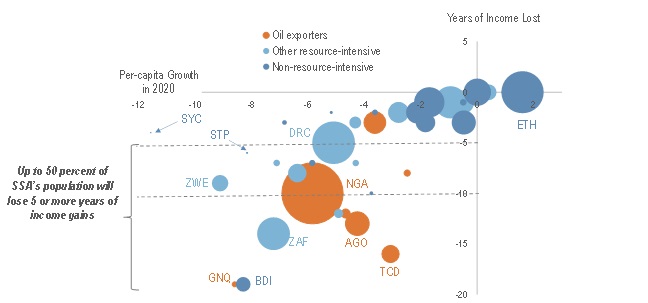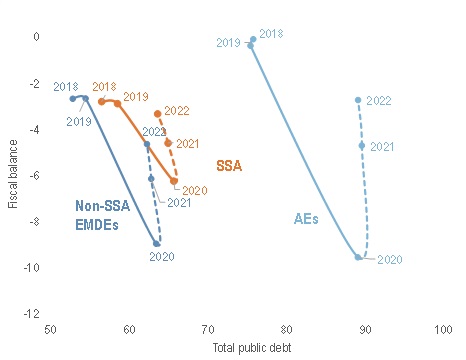Carlo Sdralevich[*]
A systemic, combined shock
The impact of the pandemic has been direct—through the health costs and curbs on economic activity from the lockdown and other public health measures—and indirect, through the fall in global demand for Sub-Saharan Africa (SSA) commodities and services, primarily tourism. Under the impact of the pandemic, SSA real GDP is estimated to have contracted by 3 percent in 2020, the largest decline on record, about 7 percentage points lower than projected in the last World Economic Outlook (WEO) before the pandemic, in October 2019.
In 2020, COVID-19 has affected SSA in different ways than other regions. Infection and mortality rates have remained much lower, partly due to lack of testing especially in the initial phases of the pandemic, but likely also thanks to the young demographic and relatively few transport connections to the rest of the world. Cumulative infections in SSA as of February 10, 2021 were 2,438 per million compared to 83,132 per million in the US and 41,857 per million in Europe. Further, because of uneven administrative capacity and the presence of large informal sectors, lockdowns have been rather short and rarely strict, since imposing and maintaining them has been difficult, and governments have been reluctant to maintain restrictions for long periods given that many households do not have precautionary savings and can rely on fewer safety nets than in higher income countries.
Uneven impact and development setback
No country has been spared, but the growth impact has been uneven mainly depending on the economic structure of individual countries. The worst-hit include the tourism-dependent countries, such as Seychelles and Mauritius, and the oil- and, to less extent, the non-oil commodity exporters, which have suffered under the global decline in prices. The commodities that have seen an increase in prices—most notably gold, thanks to the risk-aversion especially at the outset of the pandemic—have not done well enough to reverse the overall decline in terms of trade. In contrast, countries with a diversified economy, such as Rwanda and Cote d’Ivoire, have managed to achieve low but positive growth last year.
Figure 1. Real GDP growth below expectations (percentage points)

Source: IMF, World Economic Outlook and IMF staff calculations.
Note: Blue bars represent the real GDP growth; yellow dots represent the projections of the real GDP growth for 2020 estimated by IMF World Economic Outlook before the pandemic outbreak.
Capital flows also suffered: FDI to SSA is estimated to have declined by more than 20 percent compared to 2019, and market-access countries have seen net outflow of portfolio investment of more than a USD 20 billion net outflow or 1 percent of SSA GDP, particularly acute in the first phase of the crisis, before the global liquidity injection by reserve currency central banks.
When mapped to years of income gains, the per-capita income loss in 2020 translates in a slide backward by more than six years for about 50 percent of the SSA population (Figure 2).
Figure 2. Loss in per-capita income

Source: IMF, World Economic Outlook and IMF staff calculations.
Note: Each circle is proportional to the size of the population. The y-axis represents the number of years of per-capita income that was wiped out in 2020.
Long, risky recovery ahead
The IMF foresees a long and uneven recovery for SSA countries in the years ahead. On average, SSA countries’ real income is expected to return to 2019 levels only in 2022. The upturn is likely to take longer for some groups of countries, particularly oil exporters and natural resource-intensive economies.
This broadly V-shaped recovery, however, is subject to large uncertainties. The biggest relates to the evolution of the pandemic. In this regard, the outlook has become much more complex than how it appeared at the end of 2020. The pandemic may continue to depress the global economy if new, more infectious variants become dominant, and hold back the recovery in demand for SSA exports and capital flows to the region. In SSA, a second wave is hitting countries hard, with the number of infections in many countries higher than the peak in the spring of last year. Even if fatality rates remain relatively low, compared to other Emerging Markets and Developing Economies (EMDEs) and Advanced Economies (AEs), health facilities have been under pressure, and some governments are reintroducing restrictions (even though not full-blown lockdowns) and enforcing social distancing behaviors. Furthermore, the timeline of the region’s exit from the health crisis has become more uncertain as it is now clear that LICs will substantially lag other countries in the roll-out of vaccination campaign.
This is due to a number of reasons, primarily the rationing out from the initial production of the vaccines because of the pre-purchase strategy extensively adopted by advanced economies, but also difficulties in mobilizing the financing necessary to purchase enough vaccines to cover most of the population and achieve herd immunity. The COVAX initiative, for example, subsidizes only the coverage of 20 percent of the population in eligible countries, and while it will facilitate the procurement of vaccines to reach 60 percent, the cost of the additional coverage rests with national budgets.
Countercyclical policies
SSA countries’ ability to put in place a strong fiscal response to counteract the growth shock of the pandemic has been smaller than in advanced economies given the lack of fiscal space and budget financing—reflected in a significantly more limited scaling up of government spending and deficits. In 2020, SSA countries on average were estimated to have increased government deficits by 3 percentage points of GDP, compared to double that amount in non-SSA emerging and developing countries, and three times for AEs (Figure 3).
Figure 3. Fiscal Balance and public debt, 2018-22

Source: IMF, World Economic Outlook and IMF staff calculations.
In addition, many SSA countries were already suffering from high levels of public debt and debt vulnerabilities even before the pandemic, as underlined by the rising numbers of countries at high risk of debt distress or in debt distress based on the joint World Bank-IMF Debt Sustainability Framework, which has surged from eight in 2015 to 17 by end-2020. The large increase in government deficits to tackle the pandemic further exacerbated these debt vulnerabilities. Governments must now strike a difficult balance between maintaining targeted support to the economy and social protection to help the poor, while gradually bringing government deficits in line with a more sustainable medium-term fiscal path that can reduce debt vulnerabilities.
Figure 4. SSA average public debt

Source: IMF staff calculations.
Opportunities for a transformative recovery
The shape of the recovery will depend on the extent SSA governments are able to use the crisis as an opportunity to implement transformative reforms that address the structural weaknesses of the pre-COVID era. In many countries, domestic revenue mobilization, for example by broadening the tax base and rationalizing exemptions, is needed to increase the systemically low level of government revenues. Stronger social protection systems should be strengthened to reverse the increase in poverty induced by the pandemic, while making a more efficient use of scarce public resources. Government policies to expand SSA countries’ connectivity and digitalization can support both a more efficient administration and boost the private sector. More transparency and stronger governance are essential to reduce corruption—one of the biggest obstacles to the development of a dynamic private sector in many countries in the region. Finally, governments can adopt policies to facilitate the transition to a greener economy, e.g., through carbon taxation.
Financing needs
But, returning to a robust recovery path will also depend on filling the large financing gap generated by the pandemic. IMF staff has calculated that gross financing needs in the region may amount to $900 billion for 2020-23. The financing gap is estimated at $120-130 billion in the same period. The international community has a critical role to play in filling this gap, even though an increase in aid from advanced economies will be challenging as governments and private sector in those economies struggle themselves to return to normalcy.
[*] African Department, International Monetary Fund.
The following is a summary of the presentation made at the workshop on “Emerging economies during and beyond the Covid crisis: insights and perspectives” organized on December 11-12, 2020 by the Osservatorio sulle Economie Emergenti di Torino (OEET). Charts, data, and projections are based on the October 2020 Regional Economic Outlook for Sub-Saharan Africa, with later updates.
The views expressed in this article are those of the author and do not necessarily represent the views of the IMF, its Executive Board, or IMF management.









